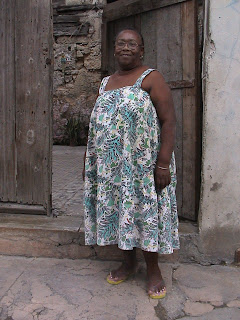Late last week as I sat with the ancestors, I had a very clear image of María Isabel Reyes—Asonsimeneco. When I met her in 2004 with David Brown, she was all heart. Never a star, María Isabel was content to live in her small house and offer coffee to those who visited. Just as in life, she appeared warm, grounded, unambitious and just grateful for the attention.
Until her passing a couple years back, she was the senior Asojano priestess at the Cabildo Arará Sabalú Nonjó in Matanzas. Born on April 16, 1944, she was initiated on July 6, 1954 at age ten. Amelia Mora—Chiarré was her oyugbona, and Dolores “Lola” Vinajera—Juniko had Asojano made and served as her godmother. Lola had been made by Flora Heredia, who had made Towosi (the Arará Yewá). María Isabel waited 36 years to initiate her first priest, and that was Pedro Abreu—Asonyanye on February 20, 1992. In time she gave other Asojanos and even made a young man from Miami.
While a legitimate defender of the Sabalú idea that only those who have made Asojano can give or make the fodun, María Isabel said she respected Babalú-Ayé Lucumí.
(Thanks to David H. Brown for the photo.)

Love this
ReplyDeleteGlad you liked. Just curious to know what particularly you liked?
DeleteHola muchas felicidadez pot tu blog
ReplyDeleteSoy Ahijado de mabel ( yoyima ) ahijada de maria isabel por lo qu entiendo la ultima hija de azojano que hizo maria isabel reyes.
Fui coronado en la misma casa de la difunta que ya fue comprada por yoel ( oloriton ) hijo de oya, ami y mi pareja nos hicieron en arara
Me gustaria saber mas de guero y como dev de ser atendido ya que a los dos no los entreagron
Tambien poder contactar a pedro abreu ya que es mas facial llamar a eeuu qye a cuba
Haré lo posible para presentar mas sobre Güeró. Pedro Abreu sí vive en Cuba así que no le facilite nada. Mándeme un correo si quiere su teléfono en la Habana.
Deletehola soy de venezuela me podría facilitar el teléfono del sr pedro de abreu este es mi correo ben-30@hotmail.com, mi ángel de la guarda es azowano.
ReplyDeleteHola,
ReplyDeleteMi papá hizo Asojuano con Pedro Abreu en Cuba; me gustaría hacer lo mismo pero hemos perdido su teléfono. Tanto el de Cuba como el que tiene en México.
Podrías facilitarme el que tengas? muchas gracias. Mi correo es: chema71@gmail.com
Gracias
ReplyDelete